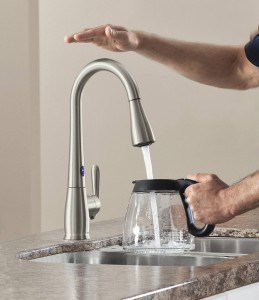 My kitchen faucet has a very slow drip and the finish is worn. I want to replace it with one that is attractive and convenient to use. I often wash dishes by hand, so what is the most efficient design to purchase?
My kitchen faucet has a very slow drip and the finish is worn. I want to replace it with one that is attractive and convenient to use. I often wash dishes by hand, so what is the most efficient design to purchase?
Most people think of a kitchen faucet as just a simple valve to turn water on or off and to set the water temperature. But the proper selection of a kitchen faucet has a significant impact on water and energy savings, not to mention convenience, health and kitchen decor.
You should never ignore a dripping faucet, even if it seems to be leaking cold water. The leak may actually be coming from the hot water side, but it feels cold by the time it gets to the faucet and drips out. Even a slow leak from the hot water line can add up to substantial energy costs over time. Keep in mind, heating water is the greatest home energy consumer following general home heating and cooling.
Two primary factors affecting water and energy efficiency of a kitchen faucet are the maximum flow rate and the convenience of controlling the flow and temperature.
For many years, two-handle (hot and cold) controls were popular. Today, one-handle kitchen faucets are almost always used. In addition to defining your style and decor, the size and shape of the faucet may impact your overall water consumption.
The Environmental Protection Agency (EPA) has a listing for plumbing products, similar in concept to EnergyStar for appliances, called WaterSense. To qualify for a WaterSense label, the faucet must be 20 percent more efficient than standard products in a category. The industry standard is 2.2 gpm (gallons per minute) maximum water flow rate. Look for the WaterSense label.
The most recent, convenient and efficient feature for faucets is the touch-control feature. Without having to turn off the water via the handle, the water flow can be controlled with the wave or touch of a hand. By not having to adjust the handle each time, water is not wasted readjusting the temperature.
This provides significant water and energy savings — particularly when rinsing during food preparation and when washing dishes by hand. For most people, using a standard faucet consumes more water and energy when washing dishes by hand than when running a properly loaded efficient dishwasher. With the touch-control feature, careful hand washing can be more efficient than the dishwasher.
Another advantage of this feature is the faucet handle is touched less often with dirty hands, so the attractive finish lasts longer. Also, with all the health concerns today about diseases from cross contamination of foods, touching the handle less is a real plus. Very few people wash the handle each time they have touched it.
Of the two no-hands technologies, I use the type that senses touch from your body (hand, forearm, elbow, etc.). It detects the slight electrical change from your touch to open or close a special valve. For example, when I am rinsing dishes, I can hold several plates in each hand and just tap anywhere on the fixture with my elbow to start or stop the water flow.
The other technology has a proximity sensor on the top and in the front of the faucet neck. Waving a hand over the top sensor triggers the solenoid. This does require one free hand. The sensor on the front of the neck senses hands when they are in a typical hand-washing position.
Tall spouts with a pull-down sprayer are convenient to use and also result in savings. They provide a professional look, which is popular in today’s kitchens. Depending upon the under-cabinet clearance, select the tallest one you can. Some are as tall as one foot. You will appreciate the height when you have to rinse a large platter or fill a large pot.
The pull-down sprayer increases the functionality of the faucet. If you use the sprayer feature option often, select one with a pause button. This allows you to stop the flow temporarily when moving utensils or rinsing various foods without having to wave over or touch the fixture.
James Dulley is a nationally syndicated engineering consultant based in Cincinnati. If you have a question about energy use or energy-efficient products, send it to: James Dulley, Electric Consumer, 6906 Royalgreen Drive, Cincinnati, OH 45244; or visit www.dulley.com.



